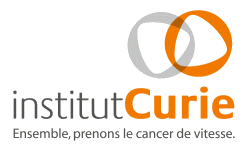
The web supplement to
Stéphanie Torrino



|
|


|
| EHD2 is a mechanotransducer connecting caveolae dynamics with gene transcription |
| Stéphanie Torrino1,3*, Wei-Wei Shen1,3*, Cédric M.Blouin1,3, Satish Kailasam Mani1,3, Christine Viaris de Lesegno1,3, Pierre Bost4,5, Alexandre Grassart6, Darius Koster7, Cesar Augusto Valades-Cruz2,3,8, Valérie Chambon2,3,8, Ludger Johannes2,3,8, Paolo Pierobon9, Vassili Soumelis4, Catherine Coirault10, Stéphane Vassilopoulos10, and Christophe Lamaze1,3 |
|
1 Institut Curie - Centre de Recherche, PSL Research University, Membrane Dynamics and Mechanics of Intracellular Signaling Laboratory, 75248 Paris cedex 05, France 2Institut National de la Santé et de la Recherche Médicale (INSERM), U1143, Paris, France 3Centre National de la Recherche Scientifique (CNRS), UMR 3666, Paris, France 4Institut Curie - Centre de Recherche, Laboratoire d'Immunologie Clinique, INSERM U932, 75248 Paris cedex 05, France 5Department of Biology, Ecole Normale Supérieure, PSL Research University, 46 rue d'Ulm, 75005 Paris, France 6Unité de Pathogénie Microbienne Moléculaire, INSERM 1202, Institut Pasteur, 75724 Paris cedex 15, France 7 Warwick Medical School Biomedical Sciences, Cell and Developmental Biology, Warwick University, Gibbet Hill, Coventry, CV4 7AL, United Kingdom 8Institut Curie - Centre de Recherche, PSL Research University, Endocytic Trafficking and Intracellular Delivery Laboratory, 75248 Paris cedex 05, France 9Institut Curie, PSL Research University, INSERM U932, 26 rue d'Ulm, 75248 Paris cedex 05, France 10Inserm/UPMC UMR_S974, CNRS FRE3617, Institut de Myologie, Paris, France *These authors contributed equally to the study |
|
Abstract Summary: Caveolae flattening results in EHD2 cytosolic release, SUMOylation and nuclear translocation. Mechanical stress leads to EHD2-dependent regulation of gene transcription. EHD2 stabilizes the caveolae reservoir upon relaxation of mechanical stress. The loss of EHD2 impairs caveolae mechanotransduction in breast cancer cells. Caveolae are small invaginated pits that function as dynamic mechanosensors to buffer tension variations at the plasma membrane. Here we show that under mechanical stress, the EHD2 ATPase is rapidly released from caveolae, SUMOylated, and translocated to the nucleus where it regulates the transcription of several genes including those coding for caveolae constituents. We also found that EHD2 is required to stabilize the caveolae reservoir during the variations of membrane tension induced by mechanical stress. Metal-replica electron microscopy of breast cancer cells lacking EHD2 revealed a complete absence of caveolae and a lack of gene regulation under mechanical stress. Expressing EHD2 was sufficient to restore both functions in these cells. Our findings therefore define EHD2 as a central player in mechanotransduction connecting the assembly and dynamics of the caveolae reservoir with the regulation of gene transcription under mechanical stress. |
| Download data: | ||
| Raw Data (cel files) | Get them (.zip) | |
| Description file (.xls) | Get it |
| Last modified July 05 2018 09:47:41 |